For many years now, the PortraitPro software has been our tool of choice for improving portraits. A couple of years ago, we reviewed PortraitPro 12, which introduced the re-lighting feature and many other improvements. Today, we are taking a closer look at what's new in PortraitPro version 15.
Creating realistically looking photo manipulations is not an easy task. Check out some videos on YouTube like, for example, this timelapse of enhancing a portrait with Photoshop. The resulting photos are great (if you have the skill to create them), but a single photo can take hours to process. What if you need to touch-up multiple photos for your clients every day? That is where PortraitPro 15 shines. As we showed in our previous review, PortraitPro offered plenty of easy to use tools, that could help you take your portraits to the next level with very little effort: from quick skin touch-ups to face sculpting, from detection of face features to a library of useful presets, etc.
The highlight of the new PortraitPro 15 is the set of makeup controls that many users have been asking for. With the version 15, you can change mascara, lipstick, bronzer, blusher, eyeliner, eyeshadows, and add eyebrow pencil.
The images below show a couple of before-and-after examples of the new makeup feature in use (combined with some other PortraitPro 15 enhancements)
. |
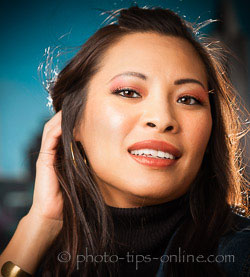 |
Example 1, before |
Example 1, after |
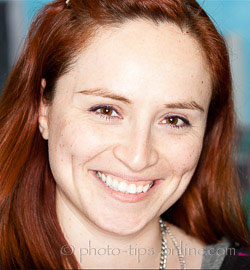 |
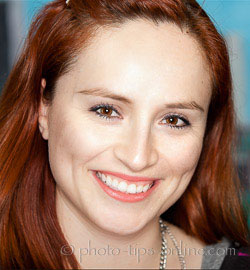 |
Example 2, before |
Example 2, after |
We found that, while in some cases not perfect, these makeup tools are quite impressive and very useful for female portraits. We also liked the degree of control you get with each element of the makeup.
The Eyeliner controls of PortraitPro 15 come with 5 different application styles and independent opacity sliders that can help you create the foundation of the eye makeup.
The mascara simulation can be tricky in post-processing, but PortraitPro 15 does a great job making it easy for everyone. You can choose from 3 different types of mascara application (Light, Medium, and Thick), plus you have False Eyelashes in regular and bold. With a few clicks, you can apply the style you want and use the additional nudge sliders to perfectly place the upper and lower lashes. Finally, the softness and texture adjustments can help making the eyelashes match your portrait really well.
The following example shows the Light Mascara and Eyeliner application.
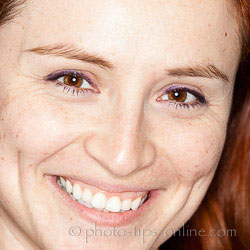 |
 |
Eyeshadows is another powerful tool in PortraitPro 15. You have a separate set of sliders for the the upper and the lower eyeshadows. You can control the inner and outer opacity of the shadows, the shine, and, of course, the colors. Best of all, the eyeshadows can be done in several different styles, including Curve, Fan, Flick, Winged, Sweep, Smokey, Blended and more.
In the examples below, you can see the Winged Eyeshadow application with False Eyelashes (lower left) and Medium Mascara (lower right).
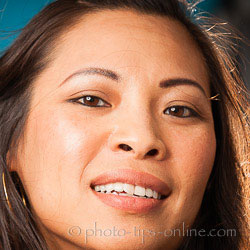 |
No makeup |
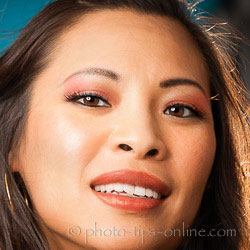 |
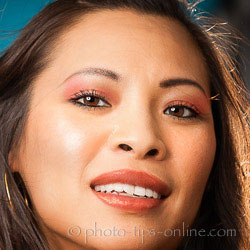 |
False Eyelashes |
Medium Mascara |
To apply or change lipstick, not only you can select a wide range of relevant colors, but also you can tweak the shine and the coverage. In addition, you can use 4 different texture presets to match or enhance the texture of the lips.
The following photos show two different lipstick colors (two upper mages) and two texture applications (two lower images).
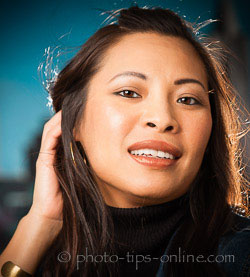 |
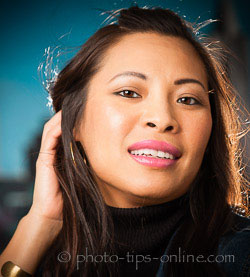 |
Brown lipstick |
Pink lipstick |
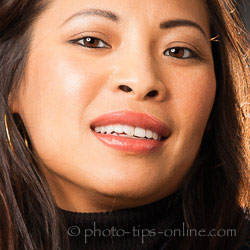 |
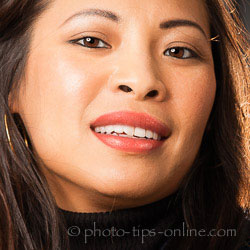 |
Lipstick, Texture 1 |
Lipstick, Texture 4 |
The bronzer, blusher, and highlights are very straightforward to use and can be handy in many cases. However, in some portraits (for example, with dramatic lighting), they may not be applicable.
For the Eyebrow Pencil tool, we haven't found much use. Though, we can see that it can be helpful depending on the type of photography you do and the needs of your clients.
We have to note that PortraitPro 15 automatically detects all face features really well in the majority of situations. However, when working with the lipstick and mascara controls, you may need to perform some fine-tuning of the lip and eye outlines for the best results. We found that 5-10 minutes is typically enough to achieve the desired look.
What we found impressive was that the makeup feature in PortraitPro 15 worked great with the re-lighting controls introduced in PortraitPro 12. If you add shine to the eyeshadows or lipstick, the reflections change depending on the position of the light source. In the left image below, you can clearly see by the reflection on the lipstick that the light source is on the camera's left. In the right image, the light source was moved to the camera's right.
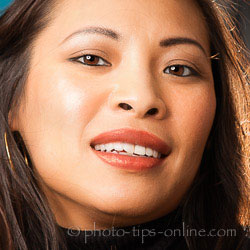 |
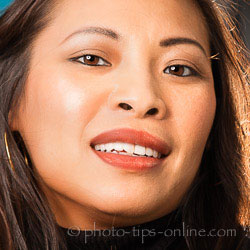 |
Besides the makeup feature, PortraitPro 15 has a number of other improvements, including updated UI, advanced skin coloring, new child mode, wide angle lens distortion correction, and more.
We typically take care of the color correction, including the skin tones, in the Photoshop Lightroom. However, we find ourselves using the skin coloring feature in PortraitPro 15 more and more, because it's much easier to select the skin area there. In addition to the common sliders, like exposure or tint, version 15 of PortraitPro comes with 18 presets you can use for different lighting situations. The presets include Vanilla, Healthy Glow, Night Club, Icy Frosting, Peach Blush, and more.
To summarize, PortraitPro is a mature piece of software that serves the purpose of quick portrait enhancements and delivers professional results with minimum effort. We like using it for family-style portraits, where we limit the use of the tools to some lightweight touchups. For the glamour photos, we tend to use the effects much more aggressively.
The release of PortraitPro version 15 brings a number of good improvements, and the brand new makeup feature is certainly the highlight of the update. With PortraitPro 15, you can now easily enhance and fix the makeup after the photo's taken.
If you don't have enough Photoshop skills or simply don't have too much time to spend on post-processing, we highly recommend getting a copy of PortraitPro 15. If you already own PortraitPro 11 or below, we definitely recommend getting the latest PortraitPro 15 because of the major features, like re-lighting and makeup, plus several other improvements. Upgrading from PortraitPro 12 can be harder to justify, because you will be mainly paying for the makeup controls. So, you should think of the work you typically do and assess the importance of the makeup enhancements in your photography. If you are not sure and the money is not too tight, we recommend switching to PortraitPro 15 even from PortraitPro 12 — you won't be disappointed ;).
PortraitPro 15 comes in 3 flavors. PortraitPro Standard is a full-featured edition. PortraitPro Studio adds plug-ins for Photoshop and Lightroom, support for the RAW and DNG formats, and batch processing. Finally, PortraitPro Studio Max has a more advanced version of the batch processing feature. For most people, we recommend PortraitPro Studio. Please check the current prices below.